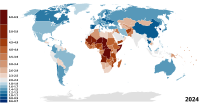
Photo from wikipedia
Taiwan and a few Asian societies have had among the lowest fertility rates in the world for the past decade. Understanding the reasons behind the low fertility and designing policies… Click to show full abstract
Taiwan and a few Asian societies have had among the lowest fertility rates in the world for the past decade. Understanding the reasons behind the low fertility and designing policies accordingly to improve fertility has been a priority of governments in the region. It what follows we examine the low fertility rate in Taiwan by studying the trend of actual fertility rate and desired fertility rate in Taiwan using an age-period-cohort (APC) model. Using the Knowledge, Attitude, and Practice (KAP) of contraception survey data between 1973 and 2004, we applied APC analyses on the actual fertility rate and desired fertility rate of married women. We found that youngest cohorts (the mid-cohort year 1983) had 10% higher actual fertility and 15% higher desired fertility compared to those who were born in 1959–1965, respectively. Additionally, we attributed current lowest-low fertility (at or below 1.3) to late marriages. There is a lag between the actual and desired fertility rates in KAP survey due to tempo effect. Furthermore, the trends of the cohort effects of both fertility rates in KAP surveys are reversing in Taiwan. Consequently, increase total fertility rate (TFR) should encourage marriage among the marriageable population and reward married and childbearing households.
Journal Title: International Journal of Environmental Research and Public Health
Year Published: 2019
Link to full text (if available)
Share on Social Media: Sign Up to like & get
recommendations!